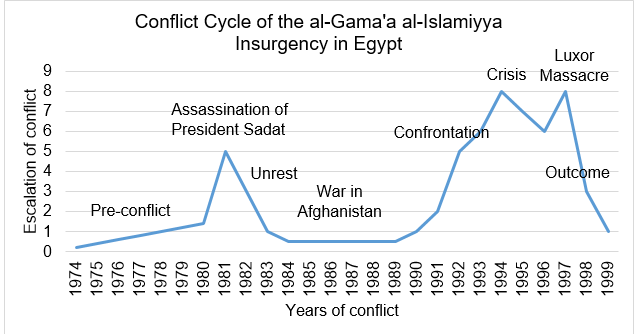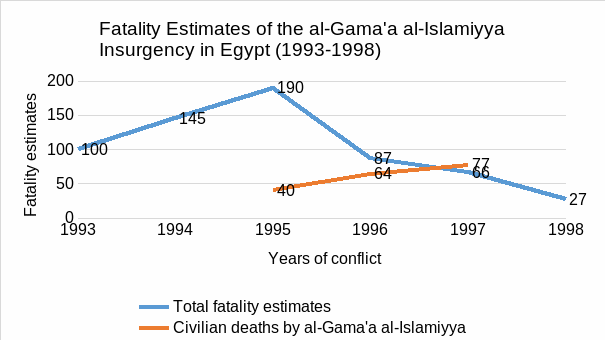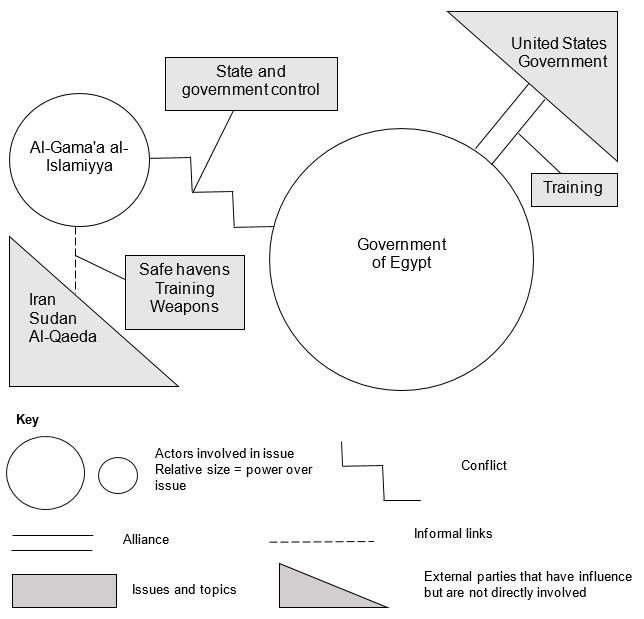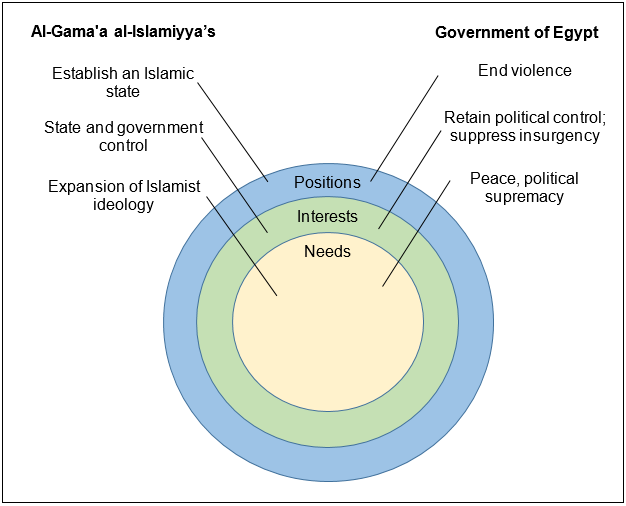Ever since the state of Egypt proclaimed its independence from the United Kingdom in 1922, it has been engaged in several international, domestic, and one-sided incidents of violence. Generally, these conflicts were linked to one of the following three reasons: disputes over the Suez Canal, disagreements regarding the Sinai Peninsula (particularly, with Israel), and insurgency of Islamist rebel groups. Apart from that, the Egyptian government has a rather poor human rights record, and it has engaged in one-sided violence on several occasions.
The present paper provides an analysis of the insurgency of the Islamist group al-Gama’a al-Islamiyya that operated in Egypt from 1993 to 1998, aiming to overthrow the secular Egyptian government to erect an Islamic state. The first part of the paper examines different historical stages and periods of the conflict, as well as the changes in battle deaths and civilian casualties over the course of the conflict. The second part provides an overview of the main actors involved in the conflict and analyses the relationships between them. The final part of the paper considers the primary causes and consequences of the conflict; throughout the paper, visuals are used to demonstrate the key concepts and elements in the analysis.
Conflict Cycle: Conflict’s Stages and Periods
Even though the al-Gama’a al-Islamiyya’s main activities did not start until 1993, the group was starting to be formed in as early as 1974. The events of the early 1970s led many people – especially youth – to grow discontent with the politics of the Sadat government, such as its friendly stance toward Israel, amicable relations with Iran, and lack of support for the Islamist trends. Until 1984, al-Gama’a al-Islamiyya was also closely linked to other jihadist groups who have collaborated to murder President Sadat in 1981. Despite the subsequent unrest and violence between the militants and government forces, the al-Gama’a al-Islamiyya’s actions did not yet constitute rebellion. The country enjoyed relative stability throughout the 1980s, as many Islamist militants turned their attention against the Soviet Union, following its invasion of Afghanistan.
However, the situation changed dramatically when the veterans returned to Egypt in the early 1990s. Al-Gama’a al-Islamiyya initiated the rebellion and engaged in a direct confrontation in 1992 by launching small attacks in Southern Egypt. 1993 is considered the first active year of the conflict, as militants and police forces began to engage in frequent violent encounters. The next year, the group appeared to dominate the government forces, but many militants were either killed or imprisoned in 1995.
Meanwhile, al-Gama’a al-Islamiyya also engaged in one-sided violence against civilians, which culminated in the 1997 Luxor Massacre that had important consequences in undermining the group’s internal structure. Despite the increasing violence, the government of Egypt refused to engage in peace talks with the militants, even when a truce was suggested by the imprisoned leaders of the group in 1996 and 1997. In fact, peace agreements proved to be unnecessary as the events of previous years have led to a gradual disintegration of the group, with the violence coming to an end in 1998 (Uppsala Conflict Data Program, n.d.).
Thus, the following stages have been identified in the conflict. It was marked by a prolonged pre-conflict stage that lasted for approximately twenty years prior to the conflict’s first active year. Despite the short period of violence and unrest following the assassination of President Sadat in 1981, the conflict was contained because the group lacked the necessary resources to engage in a direct confrontation. However, as al-Gama’a al-Islamiyya regained its human capital following the events in Afghanistan in the early 1990s, the conflict escalated rather quickly. While the group had the potential to prolong the fight well into the 1990s and even 2000s, the harsh government response combined with the group’s miscalculations led to a rather abrupt end of the conflict.

Trends in Battle Deaths and Casualties of One-Sided Violence
The UCPD data on fatality estimates over the course of the al-Gama’a al-Islamiyya’s rebellion seems to be based on accurate records, as there is little deviation between the low and high fatality estimates. Figure 2 uses the best total fatality estimates to plot the available data. Importantly, the UCPD only records the deaths that occurred between 1993 and 1998, even though the first instances of violence took place in the early 1980s, and the group was responsible for one-sided violence since 1992. However, the count of civilian deaths takes into account only three years of the conflict.
Nevertheless, one can rely on this data to examine and analyze the changes in battle deaths and civilian casualties over the course of the conflict. Up until 1995, the number of total fatality estimates had been experiencing a steady rise, until it witnessed a sharp decline in 1996. After that, the fatality figures have seen a steady decline all the way until the closing year of the conflict. The limited availability of the civilian deaths data makes the analysis more difficult, as one can only observe the steady decline of the violence from 1995 to 1997 as the group was attempting to terrorize the population of Egypt.
Regardless of the missing data for the years leading up to the conflict, the trends in fatality estimates generally follow the conflict cycle of the al-Gama’a al-Islamiyya’s insurgency. 1993 marked the start of the group’s official violence campaign, so the total number of casualties is rather high immediately. When the government responded to the al-Gama’a al-Islamiyya’s actions in 1994, the death toll went up considerably. As the group had been gaining significant power, the confrontation between the militants and police resulted in a consistently higher death toll. The same trend was carried into 1995 as the government forces aimed to eliminate the militants.
1995 is the turning point in the conflict, the battle deaths, and civilian casualties both go down after that year. The only outlier is the Luxor Massacre that carried significant political weight because of its high concentration of casualties, even though its total toll is comparatively low with respect to the estimates from other years. The final year of the conflict was marked by comparatively few deaths as the group virtually ceased to exist at that point (Uppsala Conflict Data Program, n.d.).

Key Actors and Main Issues
The use of the bubbles map helps examine the main parties involved in the conflict, as well as analyze the links and relationships between them. Two primary parties engaged in the selected conflict are al-Gama’a al-Islamiyya and the Egyptian government. Al-Gama’a al-Islamiyya is an Islamist group that originated in the 1970s as a student association. The group’s formation was a response to the politics of the Egyptian government at the time, such as the country’s defeat in the 1973 October War and its friendly relations with Iran. A major factor was the release of the Muslim Brotherhood’s leaders from the prison – an act supported by President Sadat himself.
The group followed the teachings of two individuals, Sayid Qutb, and Omar Abd al-Rahman, who claimed that Islam is the only acceptable source of authority and governance and propagated jihad as a means of achieving this goal. The Egyptian government and its police and military forces resisted the violence carried out by al-Gama’a al-Islamiyya. Thus, the main source of dispute between the two parties was the control over the state and government.
Even though initially, in its early years of conception, al-Gama’a al-Islamiyya allied with other jihadist groups operating in the country, namely, the Egyptian Islamic Jihad group, the two split in 1984, so the latter is not represented in Figure 3. Nevertheless, the al-Gama’a al-Islamiyya’s group enjoyed considerate support from other third parties during its active year. Its allies include the governments of Iran and Sudan and Usama bin Laden’s al-Qaeda group.
The partnership manifested itself in several ways: the allies supplied weapons and training to the al-Gama’a al-Islamiyya’s militants. Moreover, they also provided safe havens for those Islamist activists that needed to escape the country. Even though the al-Gama’a al-Islamiyya’s actions were condemned by several world governments, only the United States government provided direct support to the Egyptian government by conducting joint military exercises with the Egyptian forces for the purpose of training (Uppsala Conflict Data Program, n.d.). Overall, the conflict was contained within the country’s borders and little direct involvement from third parties was present.

The Key Causes of the Conflict
A treemap is a useful visual tool that helps understands how the main causes of the conflict shaped its core problem and what consequences followed after the conflict’s resolution (Fisher et al. 2000). Essentially, the key causes of the conflict can be divided into two main categories: dissatisfaction with the government’s foreign policy and Islamist ideology’s incompatibility with the secular nature of the state of Egypt. Different events regarding these two elements of Egyptian politics contributed to the formation of al-Gama’a al-Islamiyya as a domestic actor, and the government had to respond to the group’s demand.
Consequently, the core problem of the conflict was control of the state and government in Egypt. The government wanted to maintain its control over the country while al-Gama’a al-Islamiyya attempted to overthrow the government with the aim of establishing Sharia law in Egypt.
The conflict had several important implications for Egypt. First of all, the fact that violence was frequently directed at tourists significantly harmed the country’s travel industry, which is one of the main contributors to the Egyptian economy. The Luxor Massacre, in particular, had a detrimental effect on the country’s tourist attractiveness, and it caused the considerable international condemnation of the violence. Given the outcome of the conflict – that is, the disintegration of the group – another consequence was the maintenance of the political status quo, as al-Gama’a al-Islamiyya failed to convert Egypt into an Islamic state. Islamism has lost its popular appeal: even the former leaders of al-Gama’a al-Islamiyya renounced violence, apologized for their past actions, and began advocating against religious extremism (Gunaratna & Ali 2009).

Another useful tool to understand the conflict is the onion map that examines the positions, interests, and needs of the conflicting parties. These three layers represent the claims, intentions, and goals of al-Gama’a al-Islamiyya and the government of Egypt. While the positions represent what the actors claimed they wanted, the interests represented what they actually wanted. The needs are what was necessary for the parties to achieve their goal (Fisher et al. 2000).
The al-Gama’a al-Islamiyya’s group claimed they wanted to establish an Islamic state in Egypt which translates into their actual desire for state and government control. Ultimately, for them to achieve this goal, they needed to spread the Islamist ideology and make it popular among the people of Egypt. However, the group chose the wrong methods to attain this goal as their violence only drove potential supporters away.
On the other hand, the official government’s position in the conflict was ending the al-Gama’a al-Islamiyya’s violence. However, given its firm refusal to negotiate with the group’s leaders, the government, in fact, was primarily concerned about suppressing the dissent and retaining their political control. For them to do this, they needed to ensure peace and maintain political, ideological, and military supremacy over the militants.

Even though the active years of the conflict are only from 1993 to 1998, it can nevertheless be considered a protracted conflict, defined as hostility between groups based on religious and other reasons and manifesting itself in occasional violence outbreaks over a long period of time (Fisher 2001). Given the group’s activities in the 1980s, the insurgency can be considered a protracted conflict. The main difficulties associated with resolving the conflict are as follows. First of all, the two sides had absolutely incompatible political agendas that left no room for consensus or compromise. Secondly, the militants had access to many resources, both human and material, which allowed them to resist the government for quite a long time.
The conflict between the government of Egypt and al-Gama’a al-Islamiyya was a rather short one, only lasting for about six years. The duration and intensity of the conflict can be best understood by analyzing the positions and resources of the conflicting parties, as well as the consequences of their actions. The group’s internal deficiencies combined with the government’s harsh response quickly led to the demise of al-Gama’a al-Islamiyya in Egypt.
Reference List
Gunaratna, R & Ali, MB 2009, ‘De-radicalization initiatives in Egypt: A preliminary insight’, Studies in Conflict and Terrorism, vol. 32, no. 4, pp. 277-291. Web.
Fisher, RJ 2001, ‘Cyprus: The failure of mediation and the escalation of an identity-based conflict to an adversarial impasse’, Journal of Peace Research, vol. 38, no. 3, pp. 307-326. Web.
Fisher, S, Abdi, DI, Ludin, J, Smith, R, Williams, S, Wiliams, S 2000, Working with conflict: Skills and strategies for action, Zed Books, London, UK. Web.
Uppsala Conflict Data Program n.d., Egypt, Uppsala University. Web.